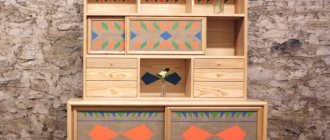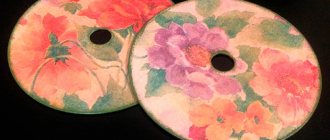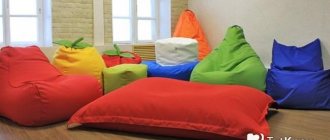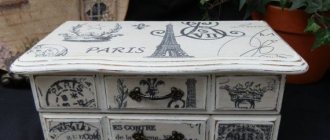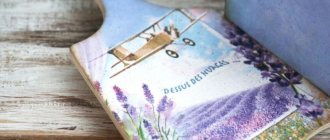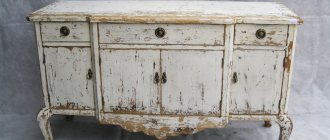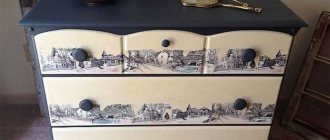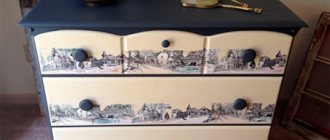Every residential property owner wants every room in his house or apartment to be attractive, interesting and unique. For this, it is considered optimal to use various techniques that are implemented on your own and contribute to the unusual design of any piece of furniture. Decoupage of furniture in the Provence style is considered an excellent solution. The master class will give you the opportunity to master the technique. By doing the decorating process yourself, you won’t need to spend a lot of money to get bright and sophisticated interior items.
Technology Provence
You can decorate furniture in different styles.
The Provence style is considered the most gentle, romantic, cozy, and homely. Most often, kitchen furniture is decorated in this style. After all, in the kitchen, delicate little things are very important to create a cozy atmosphere. Provence is a fairly popular technique. It is associated with the village, so it is relevant in the kitchen with the sea and the sun, with the smell of herbs, trees, and brings you closer to nature. The technique should include several necessary colors: white, cream, beige, pale yellow, pale green, pale blue, faded turquoise, faded orange, terracotta. Also, the Provence style is characterized by motifs of flowers, natural and artificial leaves.
Provence is simplicity, naturalness, uncomplicatedness, tenderness, warmth.
Images
For the Provence style, pictures associated with sunny France are selected. The most common ornaments are:
- small wildflowers;
- rural landscapes;
- poppy or lavender fields;
- kitchenware;
- still lifes;
- Pets;
- spices;
- Small children;
- angels;
- retro photographs;
- images of a rooster, which is a symbol of France.
Useful tips
Useful recommendations from experienced craftsmen will help you create the perfect product and avoid many mistakes:
- If the surface is not monochromatic, then you need to remove the old paint using sandpaper, and then paint the surface the same color.
- For beginners, it is better to use standard geometric objects.
- If you are using a printout from the Internet, it is better to use a laser printer so that the colors do not blur.
- Before applying the design to the surface, it is recommended to place it in cold water. This will minimize the number of bubbles.
- To smooth out the glued pattern, you need to wet your hands in water.
Within an hour after gluing, you need to monitor the picture. It is during this period that new bubbles may appear, which need to be smoothed out in time.
Decoupage of furniture in the Provence style can not only become a wonderful hobby, but also bring good income. This technique is very exciting and absolutely inexpensive. Furniture created with your own hands will be unique and will delight guests and owners for many years.
- Previous postHow to use moldings in the interior to separate wallpaper - original ideas and photos
- Next entry10 ways to zone a room using a partition with your own hands: photos and design techniques
× We recommend watching How to beautifully and originally decorate a Christmas tree for New Year 2022: photos, stylish decor and ideas How to decorate a fireplace for the New Year with your own hands: original ideas and safety rules
Grace and harmony as the basis of Provence
The freshness of the Cote d'Azur, spacious lavender fields and the refined aroma of Provencal herbs - this is what inspired French masters to create this style. “Provencal” trends in the interior were first introduced at the beginning of the 19th century. They united and continue to unite notes of romantic, calm, rustic styles. Hence the warm palette, light background, space, relaxed and natural solutions.
Floor.
Stones and noble woods were used as flooring. However, now modern tiles are an alternative. In an ordinary room, you can finish the floor with a brick or brown board. Instead of a board, it is important to use a laminate that imitates it.
Walls.
As for wall decoration, artificial stone, brickwork, and plastering are relevant. This style is not characterized by the presence of wallpaper. Most often, the walls are simply covered with plaster with a rough application.
Doors.
White interior doors are usually chosen. Doors with a soot effect look impressive: Provence is characterized by a patinated surface.
Window.
The ideal option is a window that covers the entire wall: from ceiling to floor. An alternative would be a double-glazed window frame. Imitation of wood-like windows is required. As for textiles, flowing weightless curtains, tulle in a light shade or with a floral print are suitable.
General solutions
. Prints and curved objects are presented in all their variety. By the way, you can decorate anything: not only ceilings, walls, windows and doors, but also furniture, flower pots and so on. Let's talk about the intricacies of the Provencal style in more detail.
Decoupage kitchen
Decoupage in the kitchen will update the decor, add cleanliness, freshness, and newness. Women spend a lot of time in the kitchen. The interior can become boring, but thanks to this technology you can add at least something new to the boring interior. Provence style would be an excellent choice.
If it is impossible to purchase new furniture, kitchen decoupage will help to temporarily refresh the interior and old furniture. In the kitchen, furniture wears out and gets damaged faster than in other rooms. Therefore, some defects can be covered with a beautiful pattern suitable for the kitchen.
Kitchen decoupage will help the creative housewife realize her most fantastic dreams and desires for decorating kitchen furniture.
Briefly about the main thing
Provence decor is the soul of style. This is a whole world that helps create a corner of peace of mind, imbued with the charm of the French countryside. It necessarily contains the beauty of nature, the smells of spices, wildflowers, and homemade baked goods. Each individual detail contains beauty that can demonstrate the tastes and moods of the owners. It’s easier to look for themed items in creative shops and flea markets. You can do a lot at home using the decoupage technique. Textiles complete the overall composition. Fabrics with floral prints and light tulles are suitable for its creation.
Ratings 0
Decoupage furniture in Provence style
The most noticeable detail of any room is the furniture. If you decorate it in the Provence style, then you are guaranteed the effect of a simple cozy rural house, furnished with taste.
To give it even greater exclusivity, they use all sorts of techniques: they create scuffs, shadows with the help of paints, golden or silver leaf to make the paints look faded - they tint the surface with spots of paint of a different color, use craquelure varnish, which cracks after drying, as if the furniture was painted many years ago.
To decorate in the Provence style, it is better to choose furniture with many drawers, curls, and carved elements. Cracks after craquelure should be filled with gold or silver paint; the surface of the furniture, after painting with the main paint and drawings, should be blotted alternately with gold, brown, and black paints.
All these small details will give a second life to old or new furniture - they will create a unique product, imbued with the charm and luxury of yesteryear.
Process description
- We prepare the surface for work: sand and prime.
- We paint it.
- Glue the selected images.
- We fix the “applications” with varnish.
- If there is a need and desire, we use additional methods of decoration: patination of relief elements, use of two-step craquelure, spraying, etc.
- Final multi-layer varnish coating.
Before you start decorating, you need to properly prepare the selected items.
Characteristic features of furniture finishing in Provence style:
- The predominance of vegetable and floral motifs: olives, wine, and, of course, lavender.
- Bleached interior items - the image is applied exclusively to a light surface.
- Application of artificial aging technology.
- Scuffs and scrapes on surfaces.
- The predominant calm palette: olive, white, delicate shades of blue, wheat, beige, lavender and pink.
- Author's painting of furniture items.
To give a product a unique look, decoupage masters often use special techniques.
The decoration of interior items and accessories deserves special attention. Elements woven from wicker, all kinds of forged elements, as well as beautiful openwork pillowcases, woven lace and wooden figurines fit perfectly into the overall design concept.
Methods for aging furniture
Currently, interior designers know several ways to age furniture:
- mechanical impact, which causes small cracks, scratches and other damage;
- chemical exposure using vinegar, ammonia or craquelure varnish;
- thermal exposure using a blowtorch or open fire.
The most original and unusual method of aging is the use of a special crackle varnish.
Wallpaper in the "Wallpaper Gallery" Master class on decorating bottles: decoupage with tights Decoupage of an old cabinet and table with your own hands How to make decoupage from napkins
It must be applied to the surface in even, thick layers, which, when dry, form rather unusual cracks.
After complete drying, the varnish is covered with gold or dark paint, which adds an unusual appearance to the product.
And the final layer should be a transparent varnish, which will not allow this effect to disappear.
How to decorate an old coffee table
This master class will help any beginner decorate an old coffee table using the decoupage technique.
Necessary materials:
- napkins, old newspapers or any image on paper;
- PVA glue;
- acrylic paint;
- primer;
- knife and scissors;
- brushes and stencils;
- varnish
The best one is the one with drawers and carved elements.
The first step is to polish the coffee table with sandpaper until it is completely smooth. Apply primer and wait until it dries. We prepare the paper with the image, remove the thick layer of the napkins, leaving only the top ball.
Sometimes it happens that the door does not fit into the existing interior of the room.
Removing irregularities and bubbles
We coat it with glue from the wrong side and, pressing, glue it to the surface. We remove irregularities and bubbles. Use white or black acrylic paint to paint the outlines of the image. We use the same paint to decorate the corners of the table using a stencil. After everything is dry, apply a layer of varnish.
Decoupage in the Provence style will help you get out of a difficult situation.
The first step is to polish the coffee table with sandpaper until it is completely smooth.
How to decoupage furniture in Provence style with your own hands
Most often, small
things are decoupaged to create coziness and comfort in the kitchen.
Thus, the most popular master class is on decorating a small kitchen chest of drawers
. It is perfect for storing spices and small secrets, and if you install it in the bedroom, you can store jewelry in it.
For this work, in addition to the above, you will need Provence decoupage napkins. And you can start remaking this small decorative item.
First you need to twist all the fittings on it. Unfold the napkin
and cut out a rectangle or square from it, suitable in size for the wall or front of the chest of drawers. To decorate the facade you will need to make small additions along the edges.
All furniture drawers must be carefully pushed in and the entire surface coated with glue.
Particular attention should be paid to those places where there will be folds or protrusions. Pasting the surface should begin from the bottom edge, pressing the material as tightly as possible and rolling all the raised areas of the furniture
The edges need to be folded over the sides of the product.
side
panels should be glued, aligning them along the front edge. Carefully level the surface and roll with a roller. And after that you need to paint the surface of the chest of drawers. Use a knife to cut through all the parts of the chest of drawers to ensure their mobility.
An additional decor in this case will be spray
.
To do this you will need a hard brush or toothbrush. You need to apply the desired shade of paint to it. If you then run your finger along the bristles in the direction “towards you”, you can get small drops that will fall on the surface in an interesting way. After this, you should cover the surface with varnish and screw on the fittings
.
Large furniture is decoupaged using the same principle. But it is worth remembering that for this you will not have to use the entire
napkin, but only some of the motifs from it. To do this, you should cut out the elements and stick them on the surface, carefully sand them and varnish them.
How is Provencal style created?
The style originated in the south of France, in the province of Provence. It combines the colors of pastoral landscapes, marine motifs of the Cote d'Azur, and the colors of the foothills of the Alps. It is full of romance, European laconicism and sophistication, full of the special charm of the 18th century. Provençal style conveys the breath of time: artificial aging techniques are used when decorating:
- products are coated with craquelure - a varnish that cracks after drying;
- in some places, artificial abrasions are made with fine sandpaper, through which the bottom layer of paint is visible, it is made contrasting;
- shadows are drawn;
- silver patina and gold leaf are imitated.
For design, select drawings depicting:
- sun-drenched seascapes;
- small meadow flowers;
- rosehip buds;
- spikelets, blades of grass;
- olive branches;
- sunflowers;
- animals;
- houses entwined with greenery;
- pastoral everyday pictures;
- rooster - this symbol of France is a frequent attribute of the Provençal style.
The colors must be light, pastel. Colors that look as if they have been bleached by the sun, bright and rich are unacceptable. Main shades:
- lavender;
- sky blue;
- indigo;
- olive;
- sand;
- beige;
- terracotta;
- light gray tones of varying saturation;
- citric;
- mint;
- light pink;
- light lilac;
- all shades of green.
Decoupage of large objects
In order to decoupage old furniture, or rather, its entire surface, napkins will not be enough. In order to decorate a box, suitcase, refrigerator or door you will need a piece of fabric
or wallpaper.
The master class describes the sequence of work:
Sand and clean the surface thoroughly. If there are small or large stains on the surface, then it should be treated with white acrylic paint
It is very important to do this, because under the wallpaper or fabric all the stains will be very clearly visible, and this can ruin the whole effect. After this, the furniture must be covered with a thick layer of PVC glue. You also need to saturate the fabric or wallpaper with the same glue.
Let everything dry a little. Prepare a container and nozzle for spraying water. Gradually moistening the surface, you need to distribute the fabric or wallpaper over the surface. If you want to get an original design, then you can decorate the furniture in patchwork style, that is, decorate it with patches. Use a rubber roller to remove any bubbles and allow the surfaces to dry. After this, you can apply one or two layers of varnish and dry the furniture again.
If you have
imagination
, then decoupaging a vase, clock, kitchen or photo frame with your own hands will be quite easy. Depending on the preferences of the craftsman, you can partially decorate the door or drawer of the kitchen cabinet.
Or you can completely change the frame or bottle using ordinary napkins
. There are a lot of finishing options, they all depend on the taste of the decorator.
Do you want a watch?
in an old style - you should use a napkin with flowers and a little crackle varnish for this.
A jug or bread box decorated in a loft or Provence style will look just perfect in your kitchen. You just need to learn how to choose the right shades of paint and color combinations so that your room is not too pretentious and uncomfortable. And most importantly, the Provence style implies slightly muted
, seemingly faded colors and paints.
Grandma's old furniture with rough outlines, as if indicating that it was made by a folk craftsman, is perfect for him. If you transform it again and again, doing the work yourself, you can create a new
room and a new design each time.
Additional decor can be gilding
in Provence style design.
It is used on moldings, corners or small decorative elements. Craquelure
is also perfect for decorating furniture in this style . If applied correctly, you can get quite unusual surfaces. This coating will ideally combine with antique-style pictures and similarly aged fittings.
With the help of decoration you can give new life to old, damaged things
And also - to turn an ordinary faceless piece of furniture into an original one, attracting attention, creating a special mood. Make your own table decoupage
This simple technique will add warmth and uniqueness to the interior.
Decoupage is a technique for decorating any surface (wood, clay, glass, metal, etc.) with ready-made designs with further consolidation of the effect. There are many stylistic solutions. One of the most popular is Provence. This style is often used in the decoration of kitchen utensils, furniture, pots, clocks, etc. It is characterized by images of bunnies, hens, cockerels, and birds. Floral designs and various options for presenting flowers, especially lavender, are very popular. The predominance of light pastel colors makes such items gentle, homely and cozy.
Decoupage happens:
- Direct (classic). The design is pasted onto the surface to be decorated.
- Reverse. When decorating transparent objects, the front side of the image is glued to the back side of the product.
- Artistic or smoky. Combination with other techniques allows you to make transitions invisible.
- Volumetric. To create an image, a special substance (paste), pieces of textile, pebbles, eggshells, etc. are used.
- When decoupage and patchwork techniques are combined, another type arises - decopatch. Many pieces of paper create the effect of a quilt made of scraps.
Summarizing
Light, bright motifs in the French style can transform a familiar, boring interior into an original designer one. To do this, you will only need available tools and general knowledge about decoupage and the Provence style. And, of course, photographs of interiors and furniture in the Provencal style for inspiration:
Decoupage of an old dining table
A little effort, and instead of the old table you will get an attractive original table. Give new life to the furniture in your home - the results of the work will please the owners and guests.
Preparing for work
Prepare the necessary materials and tools:
- Old table. If there is none, you can purchase the simplest and most inexpensive option for registration.
- Acrylic paint of white (milky, beige, pink, blue) color. Choose a background that best suits your interior.
- Dark paint for a patina effect.
- Sandpaper of different grits.
- Ammonia or simple alcohol.
- Pictures depicting flowers or other flowers in Provence style. The best option is to use decoupage cards or pictures on rice paper.
- Decoupage varnish (the most inexpensive, water-based).
- Instant coffee, water for aging the surface.
- Sponge and brush.
- Paraffin candle (white).
- PVA glue.
- Putty (to fill holes and cracks).
- Putty knife.
- Rags.
Description of work
- Before you start decorating, you should check the quality of the table fastening. If there is a need to strengthen a structure that has become loose over time, remove the old screws. Then make connections again using screws and glue.
- Thoroughly clean the table surface from old varnish and dirt using sandpaper. Remove dust.
- Wipe the table with ammonia or regular alcohol. This will degrease and disinfect the surface of the old product.
- Fill the cracks and uneven areas of the table with putty. If there are large cavities or holes, fill them with product gradually in layers. Apply the next one after the previous one has dried.
- Sand the surface again, removing any excess putty. Wipe off the dust.
- Apply dark paint to the ends, corners of the table, and protruding areas of the legs; in this project we are using lilac. Leave the paint to dry.
- Fragmentarily rub the dark-colored areas with a candle.
- Cover the entire table with white or other light paint. Leave it to dry for at least 24 hours.
- Then wipe with sandpaper the areas where the surface was treated with paraffin. The white paint will come off, revealing the dark layer underneath. This way we will achieve an aging effect.
- Select the desired decorative images from the pictures prepared in advance. Try different options for their location on the table surface.
- In order for the floral decor to look natural on the table, you do not need to cut it out, but carefully, trying not to damage the design, tear it off with your hands. The edge should be uneven.
- Glue the floral decoration onto the table surface. Place the fragment in its place. Add a little water to the PVA glue. Wet the brush in the adhesive solution, apply it over the design, moving from the center to the periphery with small, neat strokes. Take your time so that there are no air pockets, untreated surfaces, folds or creases.
- After the drawing has dried, we begin aging the table using coffee. To do this, you need to dissolve the coffee powder in water, stir until completely dissolved.
- Using a cotton pad, apply the product to the entire surface of the table. If the toning is not completely uniform, that’s good. Don’t forget to process the legs and sides of the product. This treatment of the table top, the supporting part of the table, gives a natural look to the piece of furniture.
- As a finishing touch, the finished table should be coated with two layers of water-soluble varnish. Apply layers one at a time onto a dry base. Make sure that the entire tabletop is evenly coated with varnish.
Step-by-step instruction
This process is considered simple, and its steps depend on what materials are used. The standard procedure is divided into sequential actions:
- a drawing is thought out that will be applied to the surface;
- In accordance with the invented image, a stencil is made, and for this you need to use paper with a low density;
- acrylic paint is applied to the prepared surface, and two layers are certainly created;
- Pre-made stencils are applied to the desired areas of the surface, after which a layer of glue is applied to them, for which a small brush is used;
- the furniture is left in this state for about one hour, during which the glue will dry completely;
- Next, a transparent varnish is applied, which dries within several hours;
- varnish is applied again on top, but it must be water-based;
- using a regular hairdryer creates a unique effect of a spread image, and the furniture is left in this state for about three hours;
- A layer of bronze or gold paint is applied along the edges of the drawing using a small brush.
After using any product, it is necessary to allow the structure to dry, and only then work continues.
The above procedure is the simplest and most understandable for every person, so it can be easily done with your own hands. You can watch a training video to take into account the main nuances and features of this work.
A good solution is to use the spraying technique. It makes it possible to obtain interior items that fit perfectly into the Provence style. The process itself is considered simple. To do this, purchase dark paint, as well as a brush, certainly equipped with stiff bristles. After the decoupage procedure described above, the structure is varnished. Next, a brush, previously dipped in paint, is brought to the surface, after which you need to run your gloved hand over the bristles, and you need to move towards yourself. This will allow you to get a unique pattern on the surface of the furniture.
Thus, decoupage technology involves the use of actions that make it possible to visually and artificially age various interior items. The procedure is considered easy to implement, and it uses simple and accessible materials. This will allow you to get truly unique and unusual furniture that fits perfectly into the Provence style. It will be beautiful, unique and ideally suited to the needs and tastes of residential property owners.
We conduct a master class on decoupage of a glass vase
A detailed master class and the video below will help novice decorators become familiar with the main stages of decorating ceramic products.
What should be done:
- We select the most convenient place for creativity and arrange the necessary tools in the most rational way.
- Carefully cut out the design you like from rice paper or a multi-layer napkin.
- Using a felt-tip pen, mark on the glass the places where a beautiful pattern will be applied. Marks are necessary to quickly return slipped paper to the selected place.
- Soak the napkin in a bowl of warm water.
- Before applying the image, you need to clean and treat the area with PVA glue.
- Paper is quickly applied to the adhesive base and carefully straightened from the center to the edges with a soft roller or cloth napkins. Care should be taken to ensure that no unsightly folds or air bubbles remain on the surface.
- Another layer of glue is applied on top with smooth movements of the brush.
- We paint the background with multi-colored or plain acrylic paints.
- The dried layer of glue is varnished, and then the finished product must be placed in the oven and heated to 150 degrees.
No putties are used to process glass, because the smooth surfaces of the bottles provide excellent adhesion to the applied design.
Decoupage methods
Volumetric: special air-hardening plastic is used or the relief is created with multilayer pictures. Each new design is applied to the previous one only after two layers of varnish. Each layer must be allowed to dry. Ingoda, individual parts of objects are additionally primed for volume.
Direct is the simplest and most traditional method: the prepared surface is primed, a pattern and varnish are applied.
Smoky involves additional drawing of the picture before varnishing. Shadows are created and the effect of blurred edges is created. Using this technology, the drawing looks more natural against the main background, more like a drawing.
Decopatch - tearing the design into small fragments before sticking, creating the illusion of deep cracks. If the picture is cut, a mosaic is imitated. This method is used to decorate dishes.
Reverse, used to create glass panels, decorate vases, windows above doorways. The design is glued to the glass from the outside and varnished from the back.
Decoupage of clocks in Provence style
- Carefully sand the wooden or plywood blank for the watch. If there are chips and defects in the workpiece itself, very good, we don’t level them. After all, old things do not have ideal surfaces.
- Instead of a primer, we will use acrylic paint of any dark color, but not black. It is preferable to use a dark gray, blackberry color; you can also make a lilac, or less often, a dark green base. The paint should be applied to the entire surface using a foam sponge using tamponing movements or a flat synthetic brush. Let's dry it.
- Generously rub the edges of the workpiece in places of future abrasions with a candle. At this stage, you can apply a one-step craquelure varnish, but not over the entire surface, but in fragments, almost without affecting the location of the future image. After applying the varnish, dry the workpiece according to the instructions for the varnish.
- We cover the surface of the watch with light beige paint and dry it again. So the craquelure cracks appeared. We are aging our workpiece. In places where the watch was rubbed with a candle, we go over the surface and especially along the edges with medium-grain sandpaper. Our task is to peel off the top layer of paint. If you were a little overzealous and damaged the lower dark layer in places, that’s also not a big deal. Provence fully tolerates such shabbyness. To further protect the craquelure, cover the surface with one layer of acrylic varnish.
- Paste the picture. If we work with a decoupage napkin, we separate the colorful layer and cut out or tear out the design. It is convenient to paste using the file method. To do this, place a napkin on the file with the image facing down and begin to pour water onto it very little and evenly. During the process of wetting, the napkin begins to swell and wrinkle; straighten it carefully with your fingertips. When the napkin is completely straightened, drain the excess water from the file. We attach the image to the workpiece and smooth it out. Directly through the file we roll or smooth the image, removing air bubbles. Carefully, starting from the corner, separate the file. Apply a thin layer of glue. Let's dry it.
If we paste a motif from decoupage card or rice paper
– grease the workpiece with glue, apply the image to the surface, smooth it with a rubber spatula or roller. Let's dry it.
Inspired by such a successful start, you can begin to transform larger things. But first, I would like to talk about one more way of aging furniture in the Provence style with your own hands.
Preparing for work
Before you start decorating, you need to properly prepare the selected items. First of all, you should sand the surface, especially for old furniture, you need to completely remove the paint layer. Then everything is covered with a primer, after it has dried you can move on to painting the main background.
Before you start decorating, you need to properly prepare the selected items.
Further decoration is carried out according to the chosen decoupage technique. The design is cut out or carefully torn out of the napkin, placed according to where it should be, the surface of the base must first be coated with glue. Straighten it with a brush, being careful not to damage it, then glue it with another layer of glue, applying it over the design.
Then everything is covered with a primer, after it has dried you can move on to painting the main background.
Decorate the edges with paint, decorating the surface to your liking. Allow all layers to dry. You can use a hair dryer to speed up this process. After drying, the surface is coated with two layers of varnish. The varnish can be either special for decoupage or ordinary for working with wood. To remove all irregularities, the surface is sanded with sandpaper.
Straighten it with a brush, being careful not to damage it, then glue it with another layer of glue, applying it over the design.
Among the variety of types, craftsmen very often prefer decoupage in the Provence style. This style got its name in honor of the French province. Characterized by the use of floral motifs and cool shades in the design of objects. Rustic, cozy and calm style. Decoupage furniture in the Provence style allows you to create a corner of southern France in your room. The use of pictures with a marine theme is also allowed. The abrasion is combined with hand-painted and whitened surfaces.
Decorate the edges with paint, decorating the surface to your liking.
Instructions for Beginners
To decorate a couple of things in your home using rustic decoupage, you need to prepare the following materials: dishwashing detergent, primers, pictures, a special varnish for aging, acrylic yacht varnish, PVA glue, brushes, scissors, a sponge or a piece of foam rubber for staining, sandpaper. And then:
The surface of the item must be thoroughly cleaned of dirt with a detergent. If there is any glue, paint or varnish left on it, they are removed with sandpaper.
When the paint has dried, select a pattern of suitable size, coat it well with glue and carefully, slowly, apply it to the previously determined place, carefully straightening it. A layer of glue is again applied on top, removing the remaining bubbles, irregularities and roughness.
To complete the plot, apply paint of the desired color to a sponge or foam rubber and lightly press it along the edges of the picture.
You can further decorate the product with contours, textures, shiny varnishes, paints and others.
At the end, if there are roughnesses, they are removed with sandpaper.
Preparation
Next, the preparatory work begins, consisting of performing simple and understandable actions:
- Initially, various drawers and facades are removed, which are planned to be decorated;
- various fasteners are removed from them so as not to contaminate them with the means used;
- surfaces are cleaned of various contaminants and stains, and greasy stains are not allowed;
- if there is old varnish or paint, then these coatings must be cleaned off with sandpaper, but the material from which the furniture is made must not be damaged during the work;
- After completing the work, the bases are treated with degreasing compounds.
After such high-quality work, you can begin the direct process of decoupage. You can watch the video of the preparatory stages below.
Decoupage of kitchen furniture in Provence style
Despite the huge selection of products on the market, sometimes you want to have something original. Decorating your kitchen set in Provence style ,
You can create a corner of the “French village” in your kitchen. Floral motifs in delicate shades will look good on such furniture.
It happens that old furniture that has lost its original appearance is stored in an apartment for many years.
You can use not only paper images for decoration, but also various fabrics. This decoupage technique allows you to show your imagination. The only negative is that plastic furniture is unsuitable for decoration due to its glossy surfaces. The necessary materials are purchased. Wooden cabinets are sanded and covered with a layer of primer. Then they are painted several times with acrylic paint. Apply paper designs or fabric appliqués, pre-coating them with PVA glue. After the glue has dried, you can further decorate it with paint and apply patterns with stencils. The final stage will be coating the entire surface with varnish.
Before decorating the table, you need to degrease its lid with alcohol and then thoroughly sand it with sandpaper.
All it takes is a little imagination and diligence, and uninteresting furniture will turn into a real work of art. The room will be filled with comfort, acquire charm and unique style.
We sand the sides of the table with sandpaper and cover it with several layers of decoupage varnish.
With the help of decoration you can give new life to old, damaged things
And also - to turn an ordinary faceless piece of furniture into an original one, attracting attention, creating a special mood. Make your own table decoupage
This simple technique will add warmth and uniqueness to the interior.
Decoupage is a technique for decorating any surface (wood, clay, glass, metal, etc.) with ready-made designs with further consolidation of the effect. There are many stylistic solutions. One of the most popular is Provence. This style is often used in the decoration of kitchen utensils, furniture, pots, clocks, etc. It is characterized by images of bunnies, hens, cockerels, and birds. Floral designs and various options for presenting flowers, especially lavender, are very popular. The predominance of light pastel colors makes such items gentle, homely and cozy.
Decoupage happens:
- Direct (classic). The design is pasted onto the surface to be decorated.
- Reverse. When decorating transparent objects, the front side of the image is glued to the back side of the product.
- Artistic or smoky. Combination with other techniques allows you to make transitions invisible.
- Volumetric. To create an image, a special substance (paste), pieces of textile, pebbles, eggshells, etc. are used.
- When decoupage and patchwork techniques are combined, another type arises - decopatch. Many pieces of paper create the effect of a quilt made of scraps.
Master class in decoupage technique: design of various furniture
Decorating an old chest of drawers
Using this unusual technique, you can decorate any furniture, including a chest of drawers that is no longer used for its intended purpose due to its unsightly appearance.
You can read about how to make a chest of drawers out of wood with your own hands in our article.
During the work you will need the following:
- white acrylic paints;
- sandpaper;
- cutting tool;
- drawings;
- plates;
- velor roller;
- special sponge;
Step 1. First of all, you need to clean the surface of the chest of drawers from dirt. To do this, wipe it with a damp cloth and detergent. When it dries, you will need to polish the surface with sandpaper until it is perfectly smooth.
The old chest of drawers should first be cleaned of dirt.
Step 2. Then you will need to pour the required amount of white acrylic paint into a disposable plate, and then apply it to the chest of drawers using a velor roller. Water-dispersed paint is distinguished by the fact that it dries very quickly, literally in a few seconds. Only one coat of paint will be applied, so you need to do everything carefully the first time. At the same time, if the dried paint looks translucent, then this is only for the better, because at the aging stage some layer of it is still removed from the surface.
It is better to apply paint in a thick layer to fill all empty spaces
Step 3. You need to paint all sides of the chest, including the sides. It is not forbidden to use a regular paint brush, but a roller applies the paint more evenly. In addition, this significantly speeds up the process. It is worth noting that when decorating any product in the Provence style, you do not have to be particularly careful, because the more careless the coating looks, the better.
Paint the chest of drawers with a roller and acrylic paint
Step 4 . The dresser handles need to be painted. For such purposes, you can take a thin brush or a special sponge (as in our case). It allows you to quickly paint over any small details from all sides. It is worth noting that all family members can be involved in such work. If we are talking about children, then you will need to use only special non-toxic acrylic paint for children's creativity.
Paint the handles with paint
Step 5: After painting the dresser, you should leave it for about 10-15 minutes until it dries. Even though acrylic paint dries very quickly, you should not rush.
Let the chest of drawers dry
Step 6. While the acrylic paint dries, you need to cut out the images. This should be done as carefully as possible so that fewer fragments of the white sheet remain.
Cut out the image exactly according to its outline
Step 7. The next step will be to decorate the chest of drawers in an antique style. To do this, you will need to take fine-grained sandpaper or any hard iron brush. Before starting work, it is recommended to wear rubber gloves to protect your hands. Next, you should move the sandpaper in the direction of the lines on the surface of the wood.
Sand the surface with sandpaper
In this case, it is necessary to apply quite strong pressure so that the surface is non-uniform, because the more careless it looks, the more spectacular the chest of drawers will be.
The result should be a chest of drawers with many different “antique” abrasions.
Step 8. Next, you need to take our blank pictures and coat their back side with PVA glue (the layer should be dense).
Coat the picture with PVA glue
Step 9. Then you need to attach the image to the place where you plan to fix it and coat it with another layer of PVA glue. You can arrange the pictures in any order. The main thing is that they are combined with each other.
Attach the picture to the surface of the chest of drawers
Step 10. It is necessary to carefully coat all sides of the image so that it fits as tightly as possible to the surface. In addition, there should be no air bubbles underneath. If they are, then they need to be removed, moving with sweeping movements from the center to the edge.
It’s convenient to paint over pictures with a small brush.
Step 11. To ensure that the edges of the picture do not stand out from the general background, they will need to be treated with the same white acrylic paint and a thin brush. This should be done with each picture. This method will also help if in some places the image does not adhere very tightly to the surface.
Finish the edges with white acrylic paint
Step 12. Next, you can take colored acrylic paints and add some details to the image. This step is optional and can only be done if desired.
We complement the images with other decorative elements using colored paints
It is important that these details do not stand out from the general background, but are combined with the composition
Step 13. At this stage, the product is considered ready, but in order to preserve it for many years, it is recommended to cover it with several layers of varnish. This can be a regular matte varnish or a special decorative one with a cracking effect. If you choose the second option, you can give the product in the Provence style an additional twist.
Cover the surface with varnish
Video – Decoupage of kitchen furniture
We decorate the table “antique” with French motifs
In this case, an old piece of furniture will also be used - a table that has long lost its aesthetic appearance. We will try to make a unique product out of it.
During the work you will need the following:
- decorative napkins (can be taken with any pattern, in our case they were used with French motifs);
- paint - you need to take acrylic paint of a light shade;
- gold paint for decoration;
- putty;
- sandpaper (fine-grained and coarse-grained);
- brushes
Step-by-step instruction
Step 1. The first step is to remove the old coating from the countertop. In addition, this will remove any contaminants from the surface. This can be done using a grinding machine or a special solvent. Usually everyone chooses the method that will be more convenient for them.
Old varnish needs to be removed
Step 2. Since this is an old table, it may have various chips and damage that will need to be repaired with putty.
In the same way it is necessary to hide the separated seams
Step 3. Now you need to remove the thick layer of varnish from the table legs. Doing this with a grinding machine or solvent is not very convenient due to the design features - there are small carved parts here, so we will use regular coarse sandpaper. It is necessary to remove as much of the wood as possible. After finishing the surface treatment, it must be wiped with a cloth soaked in alcohol. This is done in order to remove all kinds of traces of fat.
Sand the table legs and frame
Step 4. Next, you need to cover the table frame and tabletop with the first layer of white acrylic paint. After 10-15 minutes, you can apply the next layer in order to hide all bald spots.
Prime the base of the table with white acrylic paint
Important point! Since the first coat was used as a primer, it is best to lightly sand it with fine-grit sandpaper before applying the second.
In the same way, you need to paint the tabletop in 2 layers.
Step 5. Next, you need to decorate the table using the darkening method. To do this, some areas should be touched up with black acrylic paint. It is advisable to be careful at this stage to avoid leaving large stains. In this form, the structure must be left for some time to dry.
We create the effect of darkening the surface “antique”
Step 6. Next, you need to take a little wax for creativity or any wax candle and carefully rub all the dark spots. This is done so that the subsequent layer of white paint can be removed without any difficulty with fine-grained sandpaper. After completing the work, a large amount of wax crumb remains on the surface, which must be removed with a brush (it must be hard). It is important to carefully treat every corner. Otherwise, during subsequent painting, unsightly bumps will remain. For these purposes, you can use any brush.
Rub the darkening with wax
Step 7. Apply another layer of white paint over the darkening. Usually one coat of acrylic paint is not enough because shadow marks will show underneath. Therefore, it is necessary to apply another layer.
Cover the surface with another layer of white acrylic paint
Step 8. After applying the second layer, you need to leave the structure for a while to dry.
The edges of the table top are also darkened and painted with acrylic paint
Step 9. Once the second coat of paint has dried, you can begin sanding down the dark spots using fine-grained sandpaper. Thanks to the presence of wax, the paint will come off the surface easily. In this way, it is necessary to carefully process the entire structure of the table and the corners of the table top.
Sanding dark areas
Step 10. Next, using gold paint and a dry brush, we go over the edges of the structure, creating an unusual, decorative look for it. All movements must be very light, otherwise you will only leave stains.
We process the edges with a dry brush and gold paint
There should be a light golden shadow without any oil stains.
Step 11. The next step is to start decorating the tabletop with decoupage. To do this, you need to take decorative napkins and tear them into fragments so that the edges remain uneven.
Tearing napkins
Since the napkins are three-layered, only the translucent top layer with the image will need to be separated from them.
They must be distributed on the tabletop in the order in which they are planned to be glued. This is done in order to have an idea of what the completed drawing should look like.
Step 12. The napkin must be placed on the film and then moistened with water from a spray bottle so that it becomes damp. At this stage, you should manually straighten out any wrinkles that have formed.
Spray with water
Step 13. Next, the picture can be applied to the tabletop along with the film, after which it needs to be straightened with a rag. Next, the picture must be glued to the tabletop using PVA glue. Each side should be processed so that the image fits tightly. When the first layer has dried, you can apply the second. In the same way, you can glue all the pictures on the table, first the largest ones, and then the small ones.
Glue it to the table top
Step 14. Once the layers have dried, they will need to be sanded with fine-grit sandpaper. This is the most labor-intensive process and usually takes a long time.
Rub the surface with sandpaper
Step 15: Next you need to apply additional touches of gold paint (if required). You can also leave dark spots on the tabletop itself, the main thing is not to overdo it with the decor. After all, products in the Provence style should look relaxed.
Finishing the design of the tabletop
Step 16. Upon completion of all work, the structure should be coated with transparent varnish in several layers.
We coat the tabletop with varnish
Aging using dry brush method
As you can see, it’s quite easy to remake furniture with your own hands, creating a unique atmosphere in your home. See examples of successful remodels and get inspired!
Decoupage is a technique for decorating objects by applying a design to them. The most convenient and easiest way is to use a napkin with any suitable or favorite image as a picture. A napkin can be either the most ordinary one, taken out of a pack for everyday use, or it can be exclusive and very expensive.
Additional design will help make the product unique - applying an outline, paints, sparkles, etc. You can combine several different napkins on one product.
Considering the peculiarities of the work of each master, it is almost never possible to find two similarly designed objects.
Decorations – watches, napkins, flowers and lavender
You can add special warmth and homeliness to a Provencal interior with the help of wall clocks decorated with decoupage. To do this, you should choose napkins with the image of lavender, since it has long been the hallmark of this trend.
In addition, the Provencal interior can be complemented with various decors. Decorative plates, trays, flower pots and even spice jars decorated with decoupage will look harmonious in the kitchen. In the living room or bedroom, you should place on the table a box, a comb, a wall clock, vases and jugs decorated using decoupage techniques.
Making furniture yourself
So, you have decided to make your own furniture. First, decide what exactly you want to create? Will it be a cabinet, chest of drawers, or maybe a stool? Secondly, decide on the choice of material. Provence does not tolerate materials such as chipboard, PVC, MDF. Furniture made from these materials will definitely not be from that song.
We will not describe what is needed when making furniture. Let us describe the most important stylistic components that will distinguish it from any other style.
- Carved components. It is quite difficult to carve facades, and if you are unable to do this, simply use carved legs, handles, or sides.
- You can drive a couple of decorative nails into the ends; they will emphasize the feigned heaviness and antiquity of your product.
- Use decorative elements - this can be modeling, but carefully disguised with wood paint.
- Come up with a stencil; if it doesn’t work out, you can find it on the Internet. Use it to add personality to your furniture. You can use it, for example, on the sides of a chest of drawers. You can make an interesting move - let the furniture be light, and let the ornament match the color of your bright accent. Or you can do it differently: make both the ornament and the furniture light, but the difference in a couple of tones will look gentle and impressive.
- Naturally age the furniture, rub sandpaper along the edges, you can use the gilding method described above, in general, do whatever your imagination is capable of!
- Use heavy brass accessories such as handles. Remember that they need to be fastened at the very last stage, when the furniture is ready to take its rightful place in the room.
This is how you can easily and simply create a French province from your home, breathe into it the romance of the sounds of an accordion and the fresh smell of lavender steppes. Feel free to experiment and make new changes to your interior. You may have to try hard to recreate it at first, but your efforts will be rightfully rewarded with admiring exclamations from the guests and your family feeling the comfort of a family nest. Be creative, don’t be afraid to experiment, and everything will work out!

